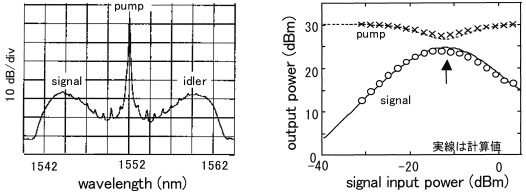Physical Science Laboratory
Quantum correlated two photons (entangled photon-pair) have the unique feature that the photon states are undetermined before measurements while the state of one photon is uniquely determined when the other photon state is measured. Utilizing entangled photon-pairs, novel communications based on quantum nature of photons (e.g., quantum cryptography) is possible. For generating entangled photon-pairs, parametric down conversion via the second-order optical nonlinearity has been widely used. However, this scheme has disadvantages for fiber communication systems, such that (1) available wavelengths are limited to short wavelength bands (< 1 μm), and (2) coupling efficiency to fiber is quite low because bulk materials are used.
We study optical parametric amplification process in optical fibers, aiming at generating entangled photon-pair suitable for fiber communications. When pump light is input into a fiber, signal and idler lights are generated in the either wavelength side of the pump via four-photon mixing process (Fig. 1) [1]. These photons are quantum correlated. They are generated at wavelengths suitable for fiber communications (1.5-μm band), and they can be directly coupled to fiber transmission lines without any coupling loss.
We are investigating a fiber optical parametric amplifier where signal light is injected into the fiber together with pump light. What we have done are, (1) experimental demonstration and theoretical calculations of unique saturation characteristics (Fig. 2), different from conventional optical amplifiers, that the signal output power increases, reaches a peak value, and then decreases, as the input signal power increases [1], (2) demonstration of noise suppression effect and low noise property operated in the output peak region (indicated by the arrow in Fig. 2), (3) observation and clarification of mechanism of spectral hole burning, (4) demonstration of optical limiter operations [2,3]. These works indicate that fiber parametric amplifier is applicable to ultra-fast optical functional devices accompanied with significant signal gain. Based on the above results, we will aim at generating entangled photon-pair in the communication wavelength band.
[1] K. Inoue and T. Mukai, Opt. Lett. 26 (2001) 10.
[2] K. Inoue, Electron. Lett. 36 (2000) 1016.
[3] K. Inoue, IEEE Photon. Technol. Lett. 13 (2001) 338.

|
|